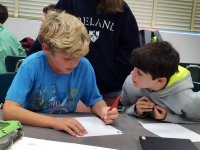Engage and Motivate Your Students Before the Holiday Break
Projects designed to embrace holiday and seasonal themes—and timed to coincide with the holiday schedule—can relieve pressure on the teacher, enthuse students, and keep them learning and engaged up to the last moment.
It's the Friday before a holiday, and despite all your efforts, your students just don't want to sit still and listen to your exciting lesson. Before I learned better, holiday seasons were the hardest times for me as a teacher. I had to exert extra energy and effort just to get students motivated enough to do any learning.
Because of the additional effort—and little return—it is no wonder that some teachers resort to showing movies and holding class parties the day before a long weekend or holiday. As much as we would like to succumb and relax like the students on the day before a holiday, the reality is that the incessant pressure to have our students achieve makes these sort of activities difficult to justify. This leaves us with the question, "How do I lower my frustration levels and at the same time keep students learning before the holidays?"
Nothing beats an effective and well thought out lesson plan for engaging students, but even the best lesson can be snowballed by the excitement of the upcoming holiday celebrations. With creative planning, you can provide effective avenues for your students' holiday energies and maintain the learning momentum, relieving the burden of forcing learning on your students.
Making Connections
To stretch out the learning, embrace holiday activities. I am a fan of thematic instruction—designing learning around a theme. A theme provides additional incentive for students to stay interested and engaged in their learning. It also provides for cross-curricular learning opportunities and collaboration with colleagues in joint learning activities.
I will demonstrate how a theme can help students stay focused. Let’s look at snow. Below are some connections we can make with nearly every content area:
- The geometry of a snowflake
- The environmental conditions necessary to produce the ice crystal structures
- The weight of snow and how it affects the architecture and construction of houses and buildings
- The effect of snow accumulated in the winter on the community water levels year-round
- The physiological effect of cold snow on bare skin (hypothermia)
- The geographical locations that have the most snow and how they deal with it
- The insulating effect of snow in cold climates and the construction and use of igloos
- The volume of water compared to the volume of snow
- The customs, legends, and cultures of people that live in the snow
- The effect of winter and snow on the Revolutionary War and other wars
- Music, poetry, or literature that have been inspired by snow
You can probably think of more examples, but this gives you a starting point.
Thematic Projects
Project-based learning is the ultimate student engagement tool. It has the capacity to wonderfully and miraculously shift the burden and responsibility of learning to the students. A well designed project can provide the incentive for students to be attentive and productive, even on the day before a holiday. Given the same theme of snow, I can envision a social studies teacher designing a project in which groups of students design systems to increase available water in developing countries.
In order to devise their solutions, the students would need to discover what areas of the world take advantage of snow runoff and then research the data in order to establish the relationship between snow pack and available water during the year.
Students could create a formula for predicting lean years and propose methods for warning the dependent communities. Their solutions could involve methods of retaining more snow runoff, new community water use policies, or ways to reduce water loss due to evaporation. They can also design more efficient homes and buildings to catch and store water and snow for the lean summer months.
Here are a few other project ideas:
- Create and then test mathematical predictions of various trajectories with snowball launchers.
- Devise a way to create the largest snow crystals.
- Identify the effect that snowy weather has had on historical battles.
- Experiment with different types of snow to find out which is the fastest for skiing and tobogganing.
- Devise ways to predict and prevent avalanches.
- Design new forms of transportation on snow.
As with any project-based learning lesson, it's important to carefully design the intellectual box in which the students will be learning. This box includes a specific time limit, available materials and resources, as well as clear expectations of the final project goals. In addition, it is essential to provide students with a well-crafted rubric that clearly illustrates what the differences are between a good project, an acceptable one, and a poor one. The other advantage of a good rubric is that it provides a teacher with an easy and fair way to grade the final projects. To grade a project or presentation, I only have to circle the corresponding rubric descriptions, and then add up the points.
Finally, assign the presentations to be due on the day before a holiday. This effectively uses time that most likely would have been wasted, and it also encourages students to not extend their holidays by skipping out on the days before.
So, as you can see, projects designed to embrace holiday and seasonal themes—and timed to coincide with the holiday schedule—can relieve pressure on the teacher, enthuse students, and keep them learning and engaged up to the last moment.
What have you found works well for helping students stay on track during the holiday season? Please share in the comments section below.
